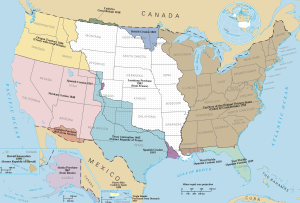US History concept chart major concepts & themes across US History: Difference between revisions
No edit summary |
|||
| Line 246: | Line 246: | ||
|- style="vertical-align:top;" | |- style="vertical-align:top;" | ||
| | | | ||
|- | |||
=== Enlightenment ideas === | === Enlightenment ideas === | ||
* Machiavelli | |||
** Roman republic | |||
* John Locke | |||
* Montesquieu | |||
* Hobbes v. Hume | |||
=== Declaration of Independence === | === Declaration of Independence === | ||
* affirmation of Locke | |||
* anti-monarchy | |||
* justifies revolution based on needs of citizens | |||
=== faction & disagreement === | === faction & disagreement === | ||
| Line 282: | Line 290: | ||
|- style="vertical-align:top;" | |- style="vertical-align:top;" | ||
|} | |} | ||
== Cultural, social & political intersections == | == Cultural, social & political intersections == | ||
Revision as of 22:41, 29 May 2021
US History concept chart major concepts & themes across US History
Objective:
- overview of core ideas for understanding historical times, persons, places, and events in U.S. History
Index
U.S. History course pages:
Periods, timeline, and major concepts[edit | edit source]
| PERIOD / TIMELINE | Major Events, Concepts & Themes | Notes & connections: details of issues, concepts, themes & events | ||||||||||||||||||||||||||||||||||||||||||||||||||||||||
|---|---|---|---|---|---|---|---|---|---|---|---|---|---|---|---|---|---|---|---|---|---|---|---|---|---|---|---|---|---|---|---|---|---|---|---|---|---|---|---|---|---|---|---|---|---|---|---|---|---|---|---|---|---|---|---|---|---|---|
|
BIG IDEAS What does it MEAN?
causality
connections
|
"The American Experience"[edit | edit source]
state colonialism[edit | edit source]
click EXPAND for chart of types/ purposes of colonial charters/ establishment
& push-pull factors[edit | edit source]Push factors from England:
Push factors to American colonies
American colonial perceptions viz Britain[edit | edit source]
| ||||||||||||||||||||||||||||||||||||||||||||||||||||||||
Founding documents & political philosophies[edit | edit source]
Enlightenment ideas[edit | edit source]
- Machiavelli
- Roman republic
- John Locke
- Montesquieu
- Hobbes v. Hume
Declaration of Independence[edit | edit source]
- affirmation of Locke
- anti-monarchy
- justifies revolution based on needs of citizens
faction & disagreement[edit | edit source]
- sectionalism
- political parties
- compromise
- conflict
- radicalism
- dissent
- to consider:
- How do Americans resolve disputes?
- Why do some Americans feel isolated and start radical movements?
- How do the big political parties adapt to those movements?
Constitution[edit | edit source]
- forms the structure of the federal government
- what does "to form a more perfect union" mean?
- Bill of Rights
- Constitutional principles
- judicial review
- change over time in interpretations,
Bill of Rights[edit | edit source]
- = strong expression of what is important to Americans:
- 1st amendment as expression of American ideals: freedom of religion, speech, press, assembly, petition of government
Electoral College[edit | edit source]
Two-party system[edit | edit source]
| PERIOD / TIMELINE | Major Events, Concepts & Themes | Notes & connections: details of issues, concepts, themes & events |
|---|---|---|
Cultural, social & political intersections[edit | edit source]
| PERIOD / TIMELINE | Major Events, Concepts & Themes | Notes & connections: details of issues, concepts, themes & events |
|---|
self-governance/ self-government[edit | edit source]
- extents and limits of self-government
- to consider:
- what does it mean and how do different people & times interpret it?
- what is democracy? How can it work? What are its limits? How does it empower people?
private v public lives of Americans[edit | edit source]
slavery[edit | edit source]
- Northwest Ordinance, 178>> << banned slavery in NW Territory
- expansion of slavery
- experience of slaves
- consequences of slavery
- upon slaves and former slaves
- upon slave-owners
- upon white non-slave owners
- 1791 Vermont state constitution forbade slavery
"frontier" western expansion[edit | edit source]
- >>details
religious awakenings[edit | edit source]
- >>details
politics & democracy[edit | edit source]
- Tocqueville
- cultural expression
- news and journalism, “pamphleteering”
- radio/ tv
- political participation
reform movements[edit | edit source]
- public and private
- religious awakenings
- agitation for reform
- reform (public/ private)
- fear, crisis, opportunism
Economic concepts & themes[edit | edit source]
| PERIOD / TIMELINE | Major Events, Concepts & Themes | Notes & connections: details of issues, concepts, themes & events |
|---|---|---|
economics[edit | edit source]
panics, recessions, depressions[edit | edit source]
to do/ sort[edit | edit source]
distance and time
land grants act 1850s overseas wars foreign involvement nicauragia wwi cold war women's rights in west b/c of fewer women in the population
|
Territorial & commercial expansion[edit | edit source]
| PERIOD / TIMELINE | Major Events, Concepts & Themes | Notes & connections: details of issues, concepts, themes & events |
|---|---|---|
|
1763 Treaty of Paris
1783 Treaty of Paris
1791 Vermont Republic
1802 Louisiana Purchase
1815 Treaty of Ghent
1818 Treaty of 1818
1819 Adams-Onis Treaty
1842 Webster–Ashburton Treaty
1846 Oregon Treaty
1848 Treaty of Guadalupe Hidalgo
1853 Gadsden Purchase
1867 Alaska Purchase
1898 Treaty of Paris
1898 Annexation of Hawaii
|
BIG IDEAS What does it MEAN?
Push & pull factors
Colonial expansion
Exploration, fur trade, land
Northwest Ordinance of 1787
Manifest Destiny
Civil War impact
Impact of technologies
Overseas expansion & acquisitions
Expansion via acquisition from European powers
Expansion via acquisition or war with Native Americans
Twentieth Century US overseas interventions
|

US territorial expansion[edit | edit source]

Acquisition or takeover of Native American lands[edit | edit source]
Pacific Island and other acquisitions[edit | edit source]
|